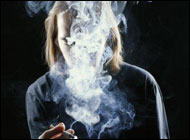Home Smoking Rules Tend to Vary by Race
Prohibiting tobacco use at home could reduce adolescent smoking rates, but the practice might be less common in black families than in white ones, a new study found.
“African-American homes have fewer full bans, and more people are allowed to smoke in those homes,” said Jessica Muilenburg, Ph.D., an assistant professor in the department of health promotion and behavior at the University of Georgia.
The study appears in the August issue of the journal Health Education & Behavior.
Researchers led by Muilenburg surveyed 4,296 Mississippi high school students about their smoking habits and home smoking rules. About three quarters of the teens surveyed were African-American; nearly one quarter were white.
Sixty-one percent of teens reported having smoking bans at home that disallowed any smoking; 32 percent of teens noted they were not allowed to smoke at home although adults were; and 7 percent of teens reported no restrictions on smoking at home. Students whose parents did not ban smoking were more likely to try smoking and smoke daily, and less likely to feel that smoking was dangerous to their health.
Overall, about 66 percent of white parents banned smoking at home completely, compared with 60 percent of African American parents.
“More people are allowed to smoke in those homes and, although it didn’t seem to translate into behavior, it did look like quitting and the attempts to quit smoking were not as high as in our white sample. So ultimately, even though they wanted to quit as much as whites, black teens were less likely to make an attempt,” Muilenburg said.
 This finding represents a health disparity in that more African-Americans lack a home environment that is conducive to quitting or preventing smoking, the authors said in the study.
This finding represents a health disparity in that more African-Americans lack a home environment that is conducive to quitting or preventing smoking, the authors said in the study.
“Not only do home smoking bans send the message that smoking is not acceptable, but they also prevent all household members from exposure to secondhand smoke,” said Jennifer Unger, Ph.D., a professor of community and global health at Claremont Graduate University in California.
Although African-American homes might be less likely to ban smoking at home, Unger said that African-American adolescents in general are much less likely to smoke than white teens, a finding supported by this study.
 “Some studies have shown that African-American parents impose stricter discipline on their children and make more absolute rules about substance use, whereas white parents are more likely to allow their children to experiment with smoking and make their own decisions,” Unger said. “Different parenting styles work for different people, but this suggests that in the African-American cultural context, absolute rules about no smoking may be more effective than letting the children experiment.”
“Some studies have shown that African-American parents impose stricter discipline on their children and make more absolute rules about substance use, whereas white parents are more likely to allow their children to experiment with smoking and make their own decisions,” Unger said. “Different parenting styles work for different people, but this suggests that in the African-American cultural context, absolute rules about no smoking may be more effective than letting the children experiment.”
Health Education & Behavior, a peer-reviewed journal of the Society for Public Health Education (SOPHE), publishes research on critical health issues for professionals in the implementation and administration of public health information programs. For information, contact Laura Drouillard at (202) 408-9804.
Muilenburg JL, et al. The home smoking environment: Influence on behaviors and attitudes in a racially diverse adolescent population. Health Education & Behavior, August 2009.
Source: Health Behavior News Service